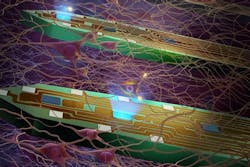Smallest implantable LEDs help understanding of individual neuron behavior
With the help of light-emitting diodes (LEDs) as small as neurons, NSF- and NIH-funded optogenetics research at the University of Michigan (Ann Arbor, MI) is helping researchers unlock the secrets of neural pathways in the brain--secrets that could lead to breakthroughs in understanding and treating neurological diseases such as Alzheimer's.
Using mice neural probes that hold what are believed to be the smallest implantable LEDs ever made, the probes can control and record the activity of many individual neurons, measuring how changes in the activity of a single neuron can affect its neighbors.
RELATED ARTICLE: Laser-based eye test for early detection of Alzheimer's
"This is a very big step forward," said Kensall Wise, the William Gould Dow Distinguished University Professor Emeritus, who was involved with the research. "The fact that you can generate these optical signals on the probe, in a living brain, opens up new doors."
"Hundreds of millions of people suffer from neurological diseases, but treatment methods and drugs are currently very limited because scientific understanding of the brain is lacking," said Fan Wu, a postdoctoral researcher in electrical engineering and computer sciences and co-first author on a new paper on the findings published in Neuron. "We have developed a tool that is needed to better understand how the brain works--and why it doesn't work--to try to solve to these problems."
In genetically modified rodents, neurons can be turned on and off with light. Typically, neuroscientists using this "optogenetics" technique shine light on a region of the brain through implanted optical fibers and record the response with a second device. This helps to reveal which regions of the brain are responsible for which behaviors. But it can't reveal how the neurons communicate with one another.
The new probes can. Each probe array contains 12 LEDs and 32 electrodes. The micro LEDs are as small as a neuron's cell body, so they can turn single neurons on and off. Meanwhile, the microelectrodes measure activity at the single-neuron level, reporting how a change in one neuron's behavior affects the surrounding network.
"Using micro-LED probes, we may tease out how the signals propagate inside the neural circuitry so that we can understand how memories are formed, retrieved and replaced," said Euisik Yoon, a professor of electrical engineering and computer science at U-M and project leader. The proof-of-concept experiment found that superficial and deep neurons in the hippocampus produce different kinds of brain waves when stimulated. Future experiments will explore how these waves are related to memory.
The research is described in the paper, "Monolithically Integrated μLEDs on Silicon Neural Probes for High-Resolution Optogenetic Studies in Behaving Animals." It is available online now, and will be the cover story of the Dec. 16 edition of Neuron. The research was funded by the National Institutes of Health and the National Science Foundation.
SOURCE: University of Michigan;http://ns.umich.edu/new/multimedia/videos/23358-mapping-the-brain-probes-with-tiny-leds-shed-light-on-neural-pathways
About the Author

Gail Overton
Senior Editor (2004-2020)
Gail has more than 30 years of engineering, marketing, product management, and editorial experience in the photonics and optical communications industry. Before joining the staff at Laser Focus World in 2004, she held many product management and product marketing roles in the fiber-optics industry, most notably at Hughes (El Segundo, CA), GTE Labs (Waltham, MA), Corning (Corning, NY), Photon Kinetics (Beaverton, OR), and Newport Corporation (Irvine, CA). During her marketing career, Gail published articles in WDM Solutions and Sensors magazine and traveled internationally to conduct product and sales training. Gail received her BS degree in physics, with an emphasis in optics, from San Diego State University in San Diego, CA in May 1986.
